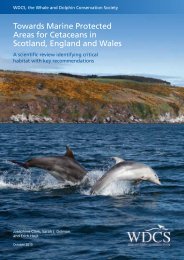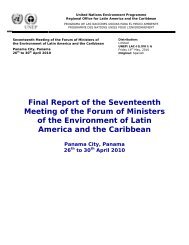Sea Turtle Recovery Action Plan for Barbados - WIDECAST
Sea Turtle Recovery Action Plan for Barbados - WIDECAST
Sea Turtle Recovery Action Plan for Barbados - WIDECAST
You also want an ePaper? Increase the reach of your titles
YUMPU automatically turns print PDFs into web optimized ePapers that Google loves.
<strong>Barbados</strong> <strong>Sea</strong> <strong>Turtle</strong>s …<br />
and stabilize beach sands) be considered favorable alternatives to armouring the beach. It is<br />
presently illegal to construct any building within 100 ft (30 m) of the high water mark (section<br />
4.21).<br />
4.134 Beach cleaning equipment and vehicular use of beaches<br />
Mechanized beach cleaning equipment can puncture or crush incubating sea turtle eggs<br />
and its use should be avoided. Rakes which reach deep into the sand and compaction resulting<br />
from tractors and trucks all diminish the hatching success of eggs incubating on the affected<br />
beach. Fortunately, mechanical cleaning of beaches in <strong>Barbados</strong> is rare, although it does occur<br />
adjacent to Sandy Lane Hotel and on the main <strong>Barbados</strong> Hilton beach, among others. The<br />
positions of any nests made on these beaches are reported to Bellairs Research Institute and nests<br />
are marked so that beach cleaning machinery does not run over them. The sandy beaches in<br />
front of most hotels are hand-raked by hotel personnel in the early morning. On some other<br />
beaches, cleaning is done by employees of the National Conservation Commission. All beaches<br />
in <strong>Barbados</strong> are public.<br />
In recent years there has been increasing use of cars and jeeps on beaches. Driving<br />
vehicles on the beach compacts the sand, damages beach vegetation, and can cause or exacerbate<br />
coastal erosion. Erosion exposes eggs in situ to wave action and reduces the amount of beach<br />
available <strong>for</strong> sea turtles to nest on. Compaction adversely affects sea turtles by crushing eggs<br />
and killing hatchlings. After breaking free from their eggs, full-term hatchlings work together<br />
with their siblings to reach the surface of the beach and then remain just below the sand until<br />
nightfall. When the sun sets and the beach cools, they are cued by the change in temperature to<br />
emerge fully and crawl to the sea. If vehicles run over the unseen hatchlings waiting below the<br />
surface, they can be fatally crushed. In addition, tyre ruts left in the sand can trap hatchlings and<br />
prevent them from reaching the sea (Hosier et al., 1981). Vehicles can also strike and kill<br />
hatchlings crawling to the sea, or frighten females away from nesting.<br />
4.135 Beach rebuilding projects<br />
Beach rebuilding projects are generally closely related to beach stabilization ef<strong>for</strong>ts in<br />
<strong>Barbados</strong> (see section 4.133). Beach rebuilding projects typically involve the redistribution and<br />
trapping of sand from existing beaches, and herein lies the problem. The existence of hotels<br />
more or less continuously along the south coast means that trying to rebuild beaches at one hotel<br />
may affect adjacent beaches and hotels. Solving such beach erosion problems has been the<br />
responsibility of the Coastal Conservation Project Unit (CCPU). For instance, the CCPU<br />
advised that the length of an already existing groyne at Sandhurst on the south coast be reduced<br />
after complaints had been made that the groyne was starving a beach on its down drift side. The<br />
CCPU also advised that a second breakwater be constructed off the <strong>Barbados</strong> Beach Village on<br />
the west coast, after the hotel became concerned about erosion. This caused considerable<br />
reaction from local residents who were worried about the erosion that had been caused in<br />
1982-1983 by a poorly designed groyne that had been erected privately by the same hotel. The<br />
same beach that was affected in 1982-1983 is well known <strong>for</strong> hawksbill nesting activity. So far,<br />
there have been no adverse effects on this beach from the new breakwater.<br />
Page 17

















